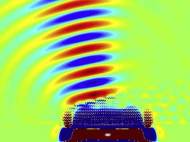New metamaterial allows negative refraction index
 Although metamaterials managed to revolutionize optics in the past decade, their performance so far has been inhibited by their inability to function over broad bandwidths of light. Stanford engineers have designed a broadband metamaterial that more than doubles the range of wavelengths of light that can be manipulated. With adjustments, the researchers believe it could lead to perfect microscope lenses or invisibility cloaks.
Although metamaterials managed to revolutionize optics in the past decade, their performance so far has been inhibited by their inability to function over broad bandwidths of light. Stanford engineers have designed a broadband metamaterial that more than doubles the range of wavelengths of light that can be manipulated. With adjustments, the researchers believe it could lead to perfect microscope lenses or invisibility cloaks.
Refractive index of most known materials found in nature have a value of 1 or above. Vacuum is considered to have the refractive index of 1, and air at a standardized pressure and temperature the lowest refractive index in nature of just a little above 1. The higher a material’s refractive index, the more it distorts light from its original path, so it’s no wonder we can’t grab onto things inside water which has the refractive index of water of 1.33.
On the other hand, a metamaterial derives its optical properties from the geometry of its nanoscale unit cells, or “artificial atoms”, rather than chemistry of the constituent atoms in natural materials. By altering the geometry of artificial atoms, one can tune the refractive index of the metamaterial to have positive, near-zero or negative values.
Previous efforts to create metamaterial have employed creation of artificial atoms composed of two constituents – one that interacts with the electric field, and one for the magnetic. A drawback to this combination approach is that the individual constituents interact with different colors of light, and it is typically difficult to make them overlap over a broad range of wavelengths.
Stanford Institute for Materials and Energy Sciences at SLAC National Accelerator Laboratory decided to design a single metamaterial “atom” with characteristics that would allow it to efficiently interact with both the electric and magnetic components of light.
Using complex mathematics known as transformation optics, the researchers began with a two-dimensional, planar structure that had the desired optical properties, but was infinitely extended. Dionne’s group “folded” the two-dimensional infinite structure into a three-dimensional nanoscale object, thus preserving the original optical properties and creating a shape that could represent the “atom”. The transformed object is shaped like a crescent moon, narrow at the tips and thick in the center.
The metamaterial consists of these nanocrescent “atoms” arranged in a periodic array. Current version of the metamaterial exhibits a negative refractive index over a wavelength range of roughly 250 nanometers in multiple regions of the visible and near-infrared spectrum.
In order for invisibility cloak technology to obscure an object or for a perfect lens to inhibit refraction, the material must be able to precisely control the path of light in a similar manner. The researchers said that they could tune the geometry of the crescent, or shrink the atom’s size, thus enabling the metamaterial to cover the full visible light range.
Although these composite materials probably won’t resemble an invisibility cloak we’ve seen in sci-fi movies, Stanford researchers are excited about the research opportunities the new material will open. The approach itself might inspire development of other metamaterials with desired optical properties, thus leading to things that have never been done before.
For more information, you can read the paper published in Advanced Optical Materials: “A Broadband Negative Index Metamaterial at Optical Frequencies” [1.26MB PDF].









I think the admin of this web page is genuinely working hard in favor of his website, since here every data is quality based stuff.